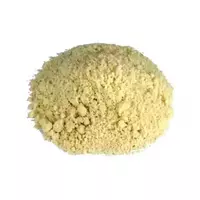Pea flour

Pea flour is rightly considered a valuable dietary product that is available to all groups of people beyond the independence of wealth. For a full diet, the receipt of a sufficient amount of proteins, vitamins and mineral salts, improving health, normalizing weight, as well as saving financial and time costs for cooking, it is advised to consume pea flour as often as possible.
Today you can buy this product not only in supermarkets, but also in specialized online stores that deliver to your home at reasonable prices. However, many culinary experts prefer to make pea flour at home - for this it is enough to grind the peas in a grinder.
So, when baking bread, as well as preparing pasta and confectionery products, adding even a small amount of pea flour (about 10-20%) to wheat flour increases their nutritional value and taste. Pea flour is often used in the preparation of donuts, vegetable cutlets, tortillas, diet bread, salted or sweet cookies.
In addition, children's porridge is prepared from a mixture with dry milk or in pure form based on pea flour. Also, a distinctive property of pea flour is that when frying, it does not absorb vegetable or animal fat oil. For example, in Israel, pea flour is used to make a delicious dish called falafel.
Composition of pea flour
In terms of protein quality in pea flour, this vegetable product is often compared even with some types of meat, while in terms of the content of vitamins and mineral salts it often exceeds them. An additional plus of pea flour is that it costs many times cheaper and does not contain cholesterol.
If you compare the composition of pea flour with its wheat analogue, you can find a lot of arguments in favor of the first product. In particular, its biological value is twice or three times higher than traditional white flour: it is much more rich in such valuable substances as fiber, vitamins A and E, pantothenic acid, calcium, zinc, potassium, magnesium, iron, phosphorus.
The benefits of pea flour
The benefits of pea flour for human health are obvious, because it is a natural source of vital amino acids (lysine and threonine). In addition, a substance called pyridoxine is contained in this product, which is directly involved in the cleavage and synthesis of these amino acids. A lack of this substance can cause seizures and dermatitis.
In addition, the fact that it contains a considerable amount of selenium also speaks in favor of pea flour. According to specialists in the field of dietetics and medicine, this element can be considered as an anticarcinogenic agent.
pea flour 298 kCal
Energy value of pea flour (Ratio of proteins, fats, carbohydrates - ju):
Proteins: 21 g (~ 84 kCal)
Fats: 2g (~ 18kCal)
Carbohydrates: 49g (~ 196kCal)
Energy ratio (bj | y): 28% | 6% | 66%
 Español
Español Français
Français Português
Português Русский
Русский 简体中文
简体中文 繁體中文
繁體中文 日本語
日本語 한국어
한국어 العربية
العربية Türkçe
Türkçe Қазақ
Қазақ Deutsch
Deutsch Italiano
Italiano Українська
Українська
